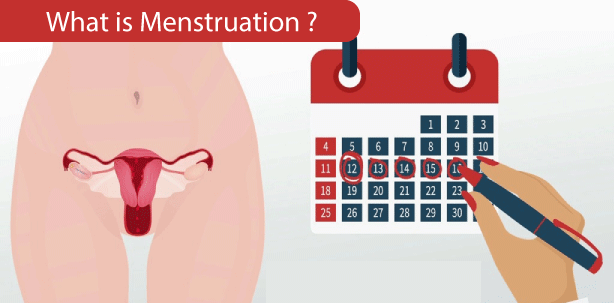Menstrual Cycle DefinitionEach month while women are menstruating, the lining of women's uterus sheds. Menstruation is also referred to as menses, menstrual period, menstrual cycle, and period. Menstrual blood, which is composed of a combination of blood and uterine tissue, exits women's body through women's vagina. 
Hormones control the commencement of the menstrual cycle. In women's body, hormones act as chemical messengers. A component of women's reproductive system, the pituitary gland in women's brain and women's ovaries produces and releases specific hormones at specific periods throughout women's menstrual cycle. These hormones cause the lining of women's uterus to thicken. This occurs to allow an egg to successfully implant into the lining of women's uterus in the event of a pregnancy. Women's ovaries release an egg as a result of hormones (ovulation). The egg travels via women's fallopian tubes and waits for sperm there. Pregnancy cannot occur if a sperm does not fertilize that egg. Women's uterus' lining degrades and sheds. What is a Menstrual Cycle?The sequence of events that take place in women's body each month as it gets ready for the potential of pregnancy is known as the menstrual cycle. Women's menstrual cycle is between the start of current period and subsequent period. Although each person's cycle is somewhat unique, the process is the same. Normal menstrual period durationNormally, a menstrual cycle lasts 28 days. However, a cycle is considered normal if it lasts between 21 and 35 days. How many days are typical between periods?Women's menstrual cycle, which normally lasts 28 days, is determined by the number of days between periods. Yet, typical cycles can last up to 35 days or as short as 21 days. How long is a typical period?During their period, most people bleed for three to seven days. Women's menstruation is regarded as usual if it lasts three to seven days. Some women have their menstrual cycle for three days, which is on the shorter end of the spectrum, and it's alright. Four Different Phases of the Menstrual CycleThe menstrual cycle phases are triggered by the increase and fall of hormone levels. Women's reproductive organs behave in specific ways as a result of women's hormones. The occurrences during women's menstrual cycle are:
When does Menstruation Usually Start?A person's period often starts at age 12, on average. Nevertheless, they can begin having periods as early as 8 or as late as 16 years old. Most people typically start menstruating a few years after developing breasts and pubic hair. A woman's period ends when she enters menopause, which normally happens at age 51. When they enter menopause, ovulation stops. When women's period hasn't come in a year, they're in menopause. What Signs Point to the Start of Women's Period?Some people have menstrual symptoms, whereas others don't. These symptoms might also range in severity. Cramps are the main symptom; women's uterus contracts to discharge its lining when they experience cramps in women's pelvic region. Some indications that women's period is coming are:
How has Women's Cycle changed throughout the Years?Women's menstrual cycle may vary from the time they are a teenager until they are in women's 40s or 50s. It's typical to have longer cycles or a greater period flow when starting women's period. After starting to menstruate, it might take the people up to three years to have regular cycles. A typical menstrual cycle lasts for:
However, it's common for women's period to alter in response to other hormonally significant life events, such as childbirth or lactation. What is Considered an Irregular Period?Anything other than a typical menstrual period is referred to as irregular menstruation. Periods shorter than 21 days or more than 35 days apart are two instances of irregular cycles.
What should Period Bleed like?They can anticipate losing two to three teaspoons (tbs) of blood during women's period.
The bleeding can vary from cycle to cycle, which is typical. It's also crucial to remember that women's normal may not be the same as someone else's. Strive to avoid comparing. If they're worried about irregular or intense bleeding during women's period, consult a healthcare professional. How to Track Period?Being mindful of women's menstrual cycle is a good thing. While not having a period may not seem like a huge deal, an irregular period can indicate a problem. Women's doctor will inquire about women's most recent period and menstrual cycles, and it is beneficial for women's provider if they know women's normal range. Knowing when they ovulate, which is when they're most likely to get pregnant, can also be learned from tracking women's period. Also, it might help they prepare for period bleeding before a big event or while on vacation. To monitor women's period:
They can also download applications to women's phone or tablet that perform all these tasks. When should I Worry about My Period?If any of the following apply to they:
Hormonal ChangesThe menstrual cycle is a series of natural changes in hormone production and the structures of the uterus and ovaries of the female reproductive system that makes pregnancy possible. The ovarian cycle controls the production and release of eggs and the cyclic release of estrogen and progesterone. The uterine cycle governs the preparation and maintenance of the lining of the uterus (womb) to receive an embryo. These cycles are concurrent and coordinated, normally last between 21 and 35 days, with a median length of 28 days, and continue for about 30-45 years.
Next TopicMicroorganism Definition
|
 For Videos Join Our Youtube Channel: Join Now
For Videos Join Our Youtube Channel: Join Now
Feedback
- Send your Feedback to [email protected]
Help Others, Please Share









